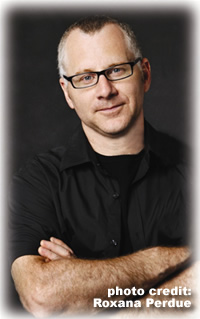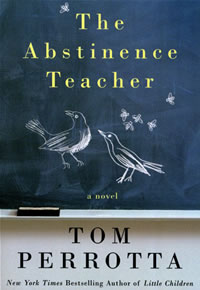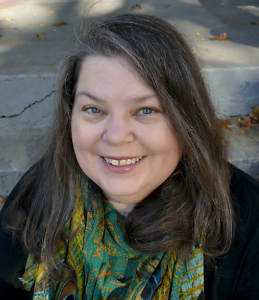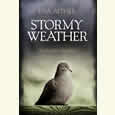Architect of the Absurd
Tom Perrotta talks with Chapter 16 about bringing page to screen, the future of reading and writing, and the delicate art of dissecting the culture wars
Few contemporary novelists can match Tom Perrotta’s gift for skewering the delusions and pretensions of contemporary American suburbanites. Perhaps none can hope to equal the empathy and compassion he dispenses along with his trademark wit. From his breakthrough novel Election, a vicious send-up of a high-school campaign for student-body president, through the acclaimed Little Children, in which a stay-at-home dad’s unlikely affair with another mom is set against the specter of a convicted child molester’s return to their bucolic neighborhood, Perrotta has become an expert at limning the perils and absurdities of suburbia.
Each of Perrotta’s novels masterfully gleans the critical conflicts that set otherwise companionable neighbors against each other. His most recent, The Abstinence Teacher, is a pointed and frequently hilarious satire of the culture wars in which a divorced high-school sex-education teacher butts heads with the evangelical right. Throughout, Perrotta maintains an admirably steady, generous sympathy for the poor souls forced to navigate the calamities of life that, however exaggerated and comic in his imaginative rendering, hit all too close to home for his many readers.
In expectation of his forthcoming visit to Vanderbilt, Perrotta answered questions for Chapter 16 via email.
Chapter 16: Though roundly acclaimed among literary novelists, much of your audience has been drawn to your work by your two film adaptations (Election, directed by Alexander Payne and starring Reese Witherspoon and Matthew Broderick, and Little Children, directed by Todd Field and starring Kate Winslet, Patrick Wilson, and Jackie Earle Haley). You’ve also written the screenplays for two of your own novels (Little Children and The Abstinence Teacher, currently being developed by director Lisa Cholodenko of The Kids Are Alright fame). Could you comment a bit on the relationship between film and literature, and on the relationship between fiction writing and screenwriting?
 Perrotta: Books and movies have always been important to me, and I’ve never seen the two forms as inherently hostile to one another. So I didn’t have the anxiety some novelists have about the transition from page to screen. That said, I’ve been very lucky in the people I’ve been able to work with in Hollywood—unlike most novelists, I feel like the adaptations did justice to the novels that inspired them, and that the films that resulted are works of art in their own right.
Perrotta: Books and movies have always been important to me, and I’ve never seen the two forms as inherently hostile to one another. So I didn’t have the anxiety some novelists have about the transition from page to screen. That said, I’ve been very lucky in the people I’ve been able to work with in Hollywood—unlike most novelists, I feel like the adaptations did justice to the novels that inspired them, and that the films that resulted are works of art in their own right.
But you’re correct to say that that the two films in some way overshadow my work as a writer. Certainly they’ve reached larger audiences. That discrepancy was huge with Election: the book barely made a ripple when it was published, and the film has become a cultural phenomenon, to the point where the name “Tracy Flick” is a recognized part of our political discourse.
Chapter 16: One of your great gifts as a writer is the ability to transform stereotypical suburbanites into believable human beings: the frustrated high school teacher jealous of his students’ talent and ambition, the humorless teenaged overachiever, the former prom king who yearns for the bygone glory of his gridiron days, the guilty husband cruising the Internet for porn while his wife thinks he’s working, the self-righteous addict in recovery who becomes an evangelical crusader, the creepy pedophile loved only by his suffering mother. Is it an intentional strategy on your part to dissect these quintessential American types? Are all humans—or at least, all twenty-first-century American suburbanites—some variation on a cliché?
Perrotta: One of the things novelists do is identify “types.” Babbitt is a type; so are Jay Gatsby and Emma Bovary. Very few individuals—urban, suburban, or rural—are utterly unique. Even eccentrics and rebels belong to commonly accepted social categories. So to that extent, I’ll agree with your proposition: most of us can be reduced to a cliché by unsympathetic observers. There’s the yoga mom; there’s the high-achieving nerd; there’s the grumpy senior citizen. The challenge for the novelist isn’t to pretend that these categories don’t exist; it’s to show us how people both inhabit and transcend the space that makes them instantly, but imperfectly, “knowable” to the people around them.
Chapter 16: Another quality of your work is your ability to satirize somewhat common but nevertheless pathetic human failings while still making your characters endearing and, for the most part, sympathetic. Do you want your audience to love your characters not in spite of their flaws, but, in some cases, because of them?
 Perrotta: I would say that people—and fictional characters—are inseparable from their flaws. If we only liked flawless people, we wouldn’t have a lot of friends, nor would we enjoy most novels. This is the reason I’ve always been puzzled by the Hollywood imperative to create “likeable” characters. Most of the characters I find fascinating aren’t particularly likeable. They can be selfish, or obsessive, or reckless, or morally compromised, or whatever—what I really want, as both a reader and writer (and as a social person, for that matter), is to encounter an interesting human being, and try to understand the inner life of that person.
Perrotta: I would say that people—and fictional characters—are inseparable from their flaws. If we only liked flawless people, we wouldn’t have a lot of friends, nor would we enjoy most novels. This is the reason I’ve always been puzzled by the Hollywood imperative to create “likeable” characters. Most of the characters I find fascinating aren’t particularly likeable. They can be selfish, or obsessive, or reckless, or morally compromised, or whatever—what I really want, as both a reader and writer (and as a social person, for that matter), is to encounter an interesting human being, and try to understand the inner life of that person.
Chapter 16: You’re a native of New Jersey, which has produced quite a few distinguished contemporary voices—Paul Auster, Amiri Baraka, Allen Ginsberg, and, most notably, Philip Roth, who has chronicled his native Newark’s changing fortunes both in nonfiction and in his Zuckerman novels. Along with these writers, you offer a substantially different image of New Jersey from that of The Sopranos, Jersey Shore, or “Born to Run.” What inspiration, if any, have you drawn from the milieu of New Jersey and the other writers who grew up there? How much does your own history there figure in the world view of your novels, or in the path you have taken as a writer?
Perrotta: It’s interesting—a lot of work about New Jersey is self-consciously mythic, or at least larger than life: you see that in “Born to Run,” for sure (“the highway’s jammed with broken heroes,” etc.), and in Roth’s nostalgic recreations of an almost utopian Newark. And you see it in less heroic form in The Sopranos or Jersey Shore—the Garden State as the epitome of a certain kind of unapologetic vulgarity. If my work is different, it’s because I try to keep it life-sized. I mostly write about ordinary people doing ordinary things—playing in bands, driving lunch trucks, going to school, falling in love, etc. But New Jersey is New Jersey—if you look hard enough, you’ll catch echoes of Springsteen and Roth and even The Sopranos in my books.
Chapter 16: Your last two novels revolve around the kind of social issues that are endlessly analyzed on morning talk shows: paranoid fear of child molesters, the excesses of modern parenthood, the exploding power and prominence of the religious right. In the last year, we’ve seen the rise of the Tea Party, which is largely driven by the kind of reactionary conservatism you satirize in The Abstinence Teacher. In the last few weeks, we’ve watched the “Tiger Mother” controversy become a national conversation, reflecting both the helicopter parenting of Mary Kay and the anxiety of confused, more narcissistic, laissez-faire parents like Sarah and Todd in Little Children. Do you see these phenomena as trends, or are they just new variations on old themes? As a novelist, are you deliberately trying to tap into these kinds of buzz topics for material?
Perrotta: In The Abstinence Teacher, I made a conscious choice to investigate the great American “Culture War,” but to do it as a novelist rather than a polemicist—that is, I tried to inhabit the minds of characters on both sides of the divide and show how they viewed the world, and how these views were formed. With Little Children, I was less conscious of tackling hot-button topics—I set out to write a steamy love story that began on a playground, and it just seemed natural to investigate the culture of parenthood in which my characters operated. The child molester subplot popped up almost of its own accord when I was well into the book, and I tried to resist it, on the grounds that it would spoil the essentially comic mood of the novel, and I turned out to be right. The book I ended up with was a lot darker and more anxiety-provoking than the one I set out to write.
Chapter 16: As a writer who struggled for some years to get his work into print and eventually rose to publishing success through unorthodox means, you must be watching the current pains of the publishing industry with interest. What, in your view, does the rise of e-books and other competing media technologies mean both for established novelists and young writers aspiring to publishing success?
Perrotta: I wish I could tell you. It’s never been easy for a new writer to break in—I learned that the hard way, as you say—and I think it’s getting harder every day. There are fewer outlets for books by new writers to come to the attention of anyone but the most hard-core readers—fewer bookstores, fewer newspaper reviews—and way more competing technologies. That’s probably good in the short term for established writers—they already have an audience—but bad in the long run for the culture of reading and writing. The main thing I’m worried about is the dwindling audience, whether the generation growing up with Facebook and iPods and Skype and on-demand video will continue to reserve some time and mental space for the solitary pursuit of serious reading.
Chapter 16: Though never at rest, the hand-wringing over the use and purpose of creative-writing degrees and classes seems to be picking up considerably as the literary world adjusts to the post-recession job and publishing markets. As one of the few literary novelists who can (apparently) make a living without a day job, what’s your take on the explosive growth of creative-writing programs and the implication of this growth for literary life in the coming years?
Perrotta: I taught writing for many years before I was able to make a living solely as a writer, so I’m very familiar with the world of academic creative writing, and the economic realities that affect everyone involved. I think creative-writing programs can be exciting communities—I had a great experience as a student at Syracuse back in the mid-1980s—but there is something worrisome about the tendency of literature to become an academic subculture, a small world in which writers write mainly for an audience composed of other writers, rather than the wider culture. But that’s as much a problem for the wider culture as it is for us writers.
Chapter 16: You have been compared to Chekhov, Cheever, Updike, and a host of other luminous analysts of the tragicomic minutiae of normal life. How do you grapple with these kinds of comparisons or influences? Are they inspiring? Intimidating? Do you think about that assessment at all when you sit down to start a new work of fiction?
Perrotta: I guess it depends on the kind of person you are. I tend to doubt myself and question my talent, so it helps sometimes to remember that other people have found something worthwhile in my work. I like to read biographies of other writers, just to remind myself of how much self-doubt is part of the job description, and how difficult it is for writers at every stage of a career—even Cheever, even Flannery O’Connor, even Henry James! —to believe in themselves enough to begin the next book or story.
Tom Perrotta will appear at Vanderbilt University in Nashville on March 17 at 7 p.m. in Wilson Hall, Room 126.





